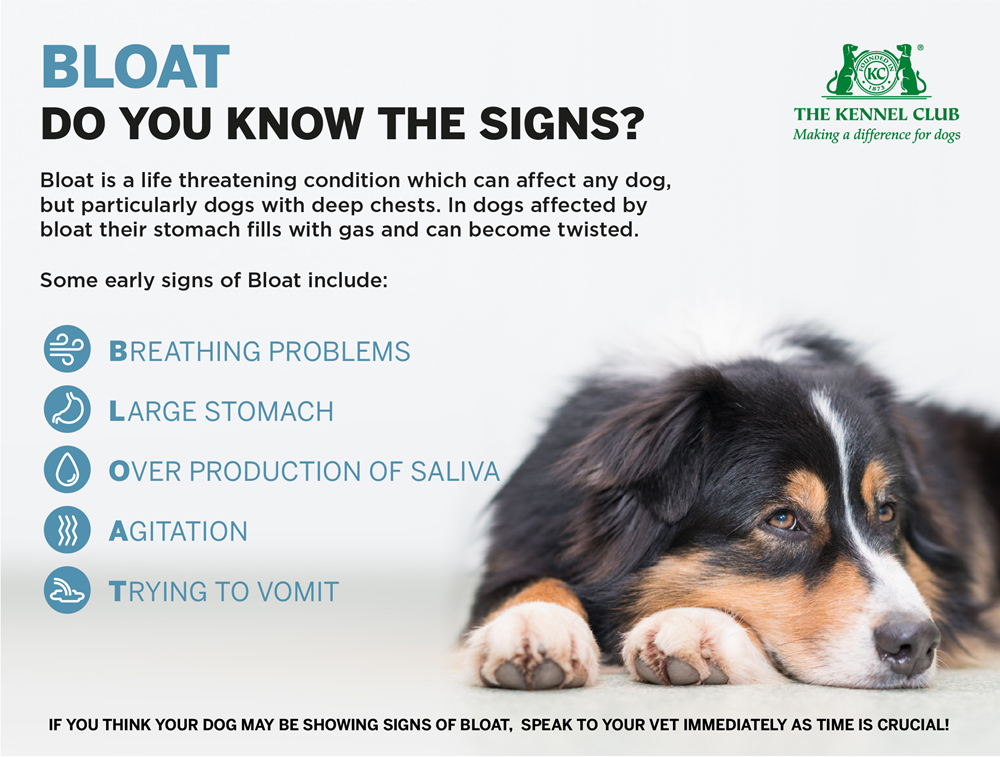Bloat Reference Guide
What is bloat?
Bloat, also known as gastric torsion, and also as gastric dilation volvulus (GDV) syndrome, is a life-threatening disorder that happens when a dog's stomach fills with gas and becomes twisted. It mainly occurs in deep-chested breeds.
What causes gastric torsion?
We don't really know why bloat happens. It is thought that if there is enough room in the abdomen for gas-filled organs to move, then occasionally they will. This is why the condition is most common in deep-chested dogs.
Why does the stomach become gas filled?
Vets believe that there are two likely triggers:
Anxiety - Animals (including humans) usually swallow more air when they are anxious. This is known as aerophagia (literally "eating air") and it is usually seen in stressed, kennelled dogs. The constant intake of air causes the stomach to balloon in size, which changes the abdomen's normal organ layout.
Diet - If dogs are moved onto very fermentable foodstuffs that produce gas at abnormal rates, the stomach can struggle and not deal with the gas efficiently by burping or passing it into the intestines.
Either way the dog is now bloated, which is an emergency in itself even if not one requiring surgery. If this inflated stomach twists however, the situation rapidly changes from serious to catastrophic.
How can I tell if my dog has bloat?
As with any emergency with your dog, if you suspect something is wrong, speak to a vet immediately, as time is crucial.
Signs to look out for:
- Anxiety: pacing around or trying to be sick, without success, may be warning signs
- Problems breathing: the expanded stomach prevents the dog from breathing properly
- Saliva: watch out for dribble or saliva from your dog's mouth
- Gut bloating: if you notice a distended stomach, seek advice fast
- Symptoms, signs & what to do. View PDF.
How is bloat treated in dogs?
Treatment for bloat will depend on how unwell your dog is. Your vet will usually x-ray them to see whether surgery is needed. Animals critical with GDV are high anaesthetic risks, so your vet may use heavy intravenous sedation first to make sure the dog is pain free and lying still.
How might my vet treat a severely bloated stomach?
If the stomach is an abnormal size your vet may:
- pass a stomach tube through the mouth and down the oesophagus to try to decompress the bloated stomach
- clip a small patch of skin on the left flank and puncture the abdominal wall with a catheter to release excess gas, which immediately decompresses the bloated stomach and restores normal breathing patterns and blood flow
Why is it important to act fast?
Time is very important in bloat cases because a twisted stomach can reduce blood flow, causing death of the dog's stomach wall (necrosis). This can lead to perforation and fatal peritonitis. Once the stomach has been partially decompressed and intravenous fluids are flowing and breathing is improved, the next step is invasive surgery. Sometimes the vet may reposition the stomach and fasten it to the inner abdominal wall to help prevent GDV happening again.
How long is my dog likely to be at the vet?
Patients are usually hospitalised for at least 48 hours as post-operative effects such as toxins released by traumatised tissues can cause major complications including heart attacks, peritonitis and sudden death.

Help raise awareness
Gill Arney & Derek Hamilton set up the canine bloat awareness campaign after Beau, their Dobermann, survived gastric torsion in 2008. They produced the above flyer (in conjunction with several vets) detailing the signs to look out for and a very simple message - if you see these signs then get your dog to the vet.
- There is a Facebook group: canine bloat awareness
Article author
This article was written by Marc Abraham, a vet based in Brighton who regularly appears on UK television.
Source : The Kennel Club United Kingdom
The hosts
of this
website make no warranty as to the accuracy of information published
either from
articles submitted or links posted.
They are provided for information only and are not intended to provide an
alternative to qualified veterinary consultation